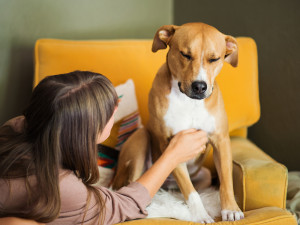DIY Physical Exam Part 1 — How to Check Your Dog’s Vitals
Veterinarian Dr. Shea Cox on how to take your dog’s temperature, find their pulse, and check their heart rate.

Share Article
As pet parents, we want to be able to fix all of our dog’s problems. Chilly? Sure, we’ll buy you that designer sweater. Need a snack? Be right back to whip up some sweet potato treats. But when it comes to sickness — as much as we’d do anything to help our pup feel better — we shy away from solving it ourselves, reserving that for the professionals.
You’re more capable in this department than you think, though: To identify an illness with your dog, you must first be able to recognize what is normal for your dog. You know your dog better than anyone else and you will have to decide when an abnormal situation warrants professional help. Sometimes the condition is so serious it leaves no doubt. Frequently, however, the changes are subtle, or happen over a longer period of time, making noticing a problem more difficult.

littleKin™ is Kinship’s home just for puppy and kitten parents. Bop over to check out expert advice, new pet tools, and special deals—all curated for your newest family member.
opens in a new tabI will provide you with information on how to perform an at-home physical exam on your dog, helping to determine and establish what is normal for your pet. It is recommended that you occasionally perform this exam — while there is nothing wrong — so you can begin to get used to what is normal. This practice will help allow for the early detection of changes in your dog’s health.
Start with the basics for your pup’s physical exam: Assessing your dog's posture, discovering their normal temperature, and obtaining a heart rate for your dog. Next we will continue with a systems approach beginning with the head area, followed by the chest, and lastly, the abdomen. At the completion of this series of articles, you should feel totally prepared to perform a screening exam on your dog.
Get Started with the Basics
First, before you start your hands-on dog physical exam, stand back and just simply look at your dog for a few minutes. (No prob, right? Could stare at the pup all day!) The posture, breathing, activity level, and general appearance can really tell you a great deal. Get a good picture of your dog’s “normal” in its relaxed home environment — this mental snapshot will help you notice any subtle change.
How to Check a Dog’s Temperature
Taking your dog’s temperature is an easy, important procedure — and learning how to take their temperature should be something all pet parents know how to do. Use a digital rectal thermometer (the ear type is less reliable and mercury thermometers can break!). Lubricate the end of the thermometer with petroleum jelly and gently insert the thermometer into your dog’s rectum about one inch for small dogs and about two inches for larger ones. If it does not slide in easily, do not force it. And do not risk taking your pet’s temperature if you feel there is a risk of being bitten.
Normal
A normal dog temperature is between 100 F and 102.5F.
When checking for a dog’s temperature, the thermometer should be almost clean when removed.
Abnormal
A temperature below 99 F or above 102.5 F is abnormal for a dog.
Evidence of blood, diarrhea, or black, tarry stool on the thermometer is abnormal for a dog; black/tarry stoolopens in a new tab can indicate a bleeding ulcer in the stomach or small intestines, or point to other sources of disease.
How to Find a Dog’s Pulse and Heart Rate
The best time to learn how to locate the pulse on your dog is before a crisis. And the best place to get a pulse on a dog is the femoral artery in the groin area. Place your fingers around the front of the hind leg and move upward until the back of your hand meets the abdominal wall. Move your fingertips back and forth on the inside of the thigh until you feel the “roll” of the dog’s artery and the pulsing sensation as the blood rushes through it. Count the number of pulses in 15 seconds and multiply by four. This will give you the pulse rate of your dog in beats per minute. Pulse rate is a highly variable finding and can be affected by recent exercise, excitement or stress. Do not use the heart rate at the sole evidence that your dog is sick or healthy.
The heart rates that are listed are for healthy dogs at rest in their home, not for animals that are evaluated in a veterinary clinic where higher heart rates might be detected due to excitement, stress of a vet visit, or disease.
Normal Pulse
For dogs, a heart rate of 60 to 160 beats per minute (bpm) is normal. Relaxed, large breed, or athletic dogs tend to have slower heart rates, while small breed dogs and puppies tend to have higher heart rates. This marked variability in heart rate stresses the importance of knowing what is normal for your individual dog.
The pulse should be easily felt and the quality of it should be strong and regular.
Abnormal Pulse
Too rapid or too slow for your individual dog.
Pulse is weak, irregular, or hard to locate.
Now you’ve assessed your dog’s general health, learned how to take a dog’s temperature, and how to check your dog's heart rate. It is important to practice these essential skills as a pet parent. Gear up for the next part of our series and get a complete basis of your dog’s health with the next part of our series:
Part 2: Examine Your Dog’s Headopens in a new tab (Eyes, Ears, Nose, and Mouth)
Part 3: Examine Your Dog’s Thorax (Neck, Chest, and Breathingopens in a new tab)
Consult your veterinarian if you’re concerned about any of these dog physical exam findings — early recognition can save your dog’s life.

Dr. Shea Cox, DVM, CVPP, CHPV
Dr. Shea Cox is the founder of BluePearl Pet Hospice and is a global leader in animal hospice and palliative care. With a focus on technology, innovation and education, her efforts are changing the end-of-life landscape in veterinary medicine.
Related articles
![Dog laying his head on owners lap while owner holds his ears.]() opens in a new tab
opens in a new tabDIY Physical Exam Part 2 — How to Check Your Dog for Infections
Veterinarian Dr. Shea Cox on how to assess your dog’s eyes, ears, nose, and mouth.
![Dog sitting next to owner]() opens in a new tab
opens in a new tabDIY Pet Physical Exam: How to Check Your Dog’s Breathing & Skin
Veterinarian Dr. Shea Cox on how to get comfortable checking your dog’s breathing, respiratory rate, and skin hydration.
![A pet parent checks their dog's stomach.]() opens in a new tab
opens in a new tabDIY Physical Exam Part 4 — How to Examine Your Dog’s Stomach and Skeleton
Veterinarian Dr. Shea Cox on how to properly examine your dog’s stomach and musculoskeletal system.


